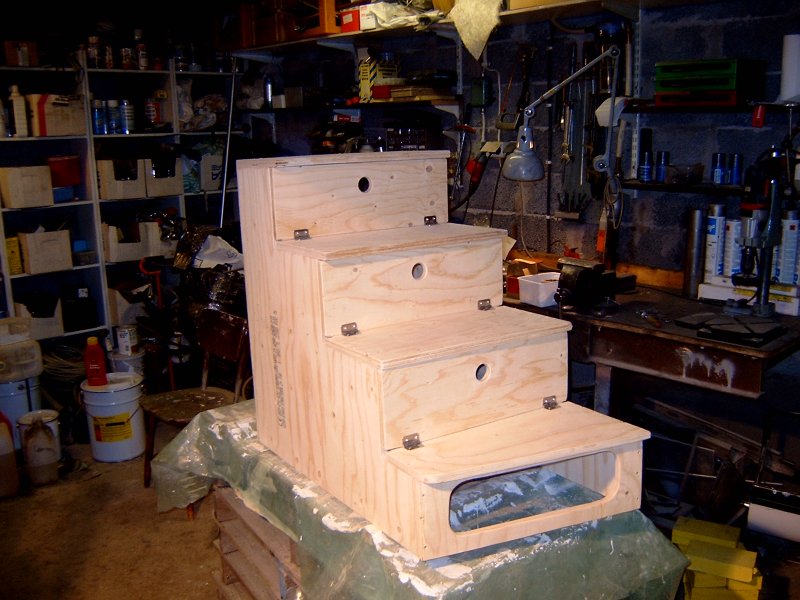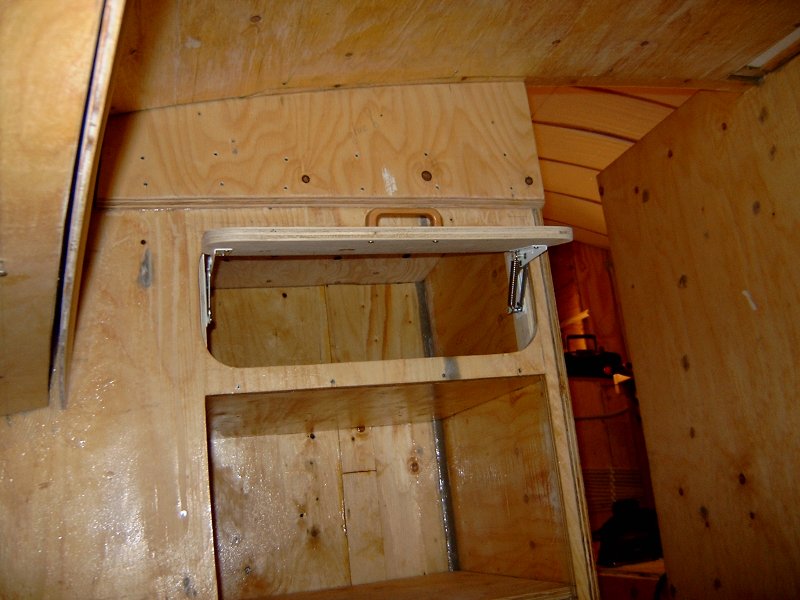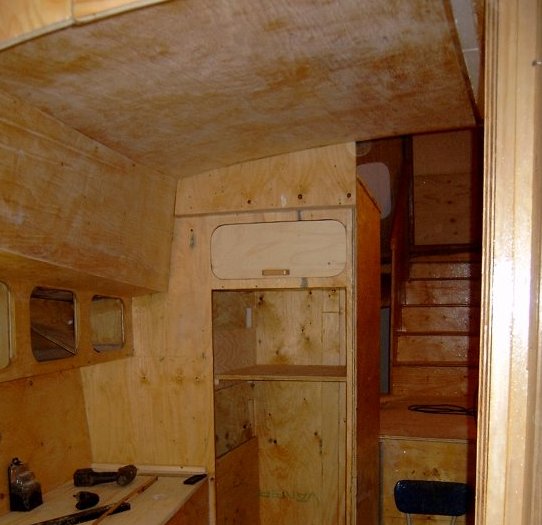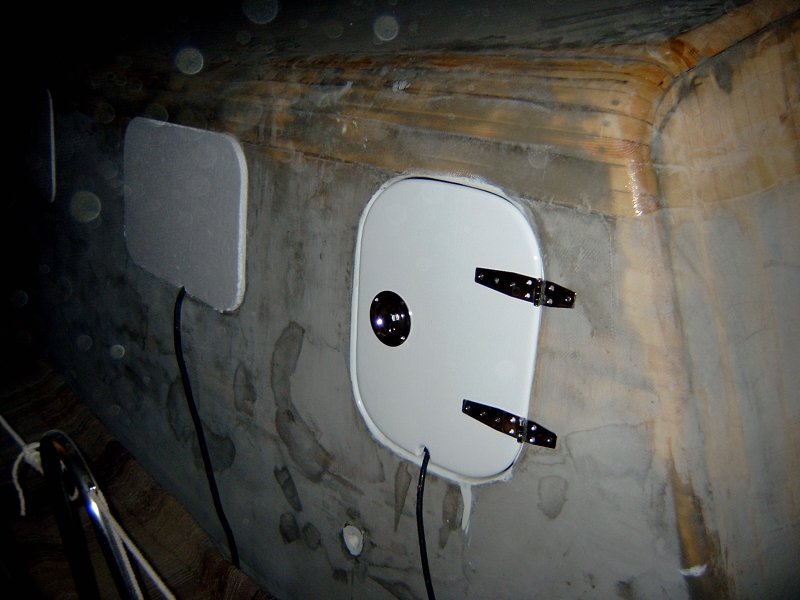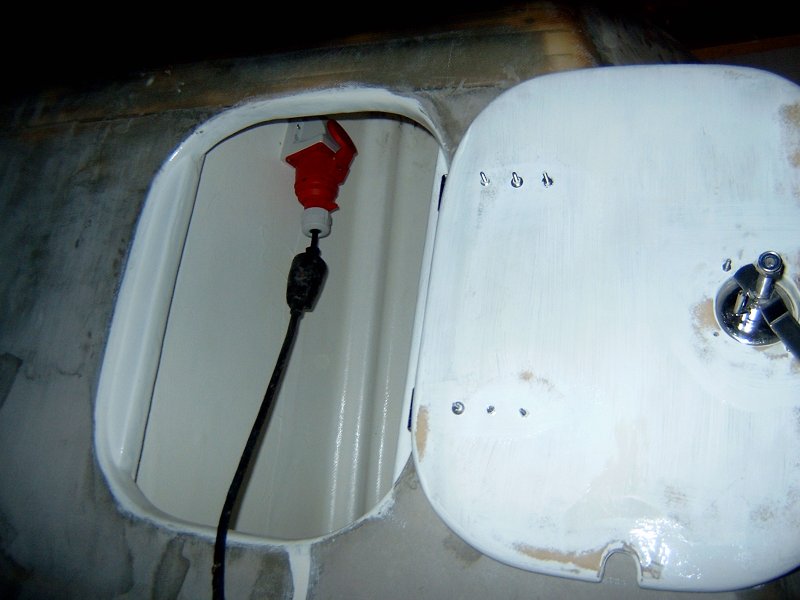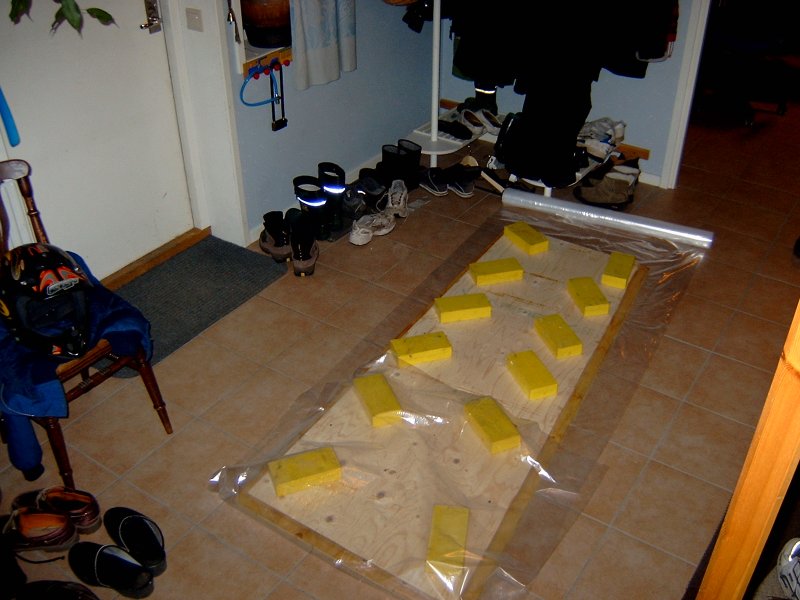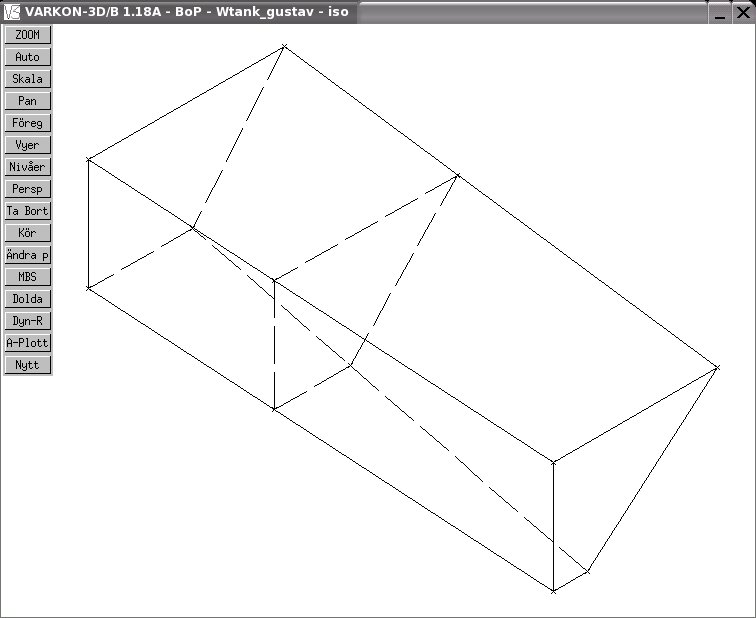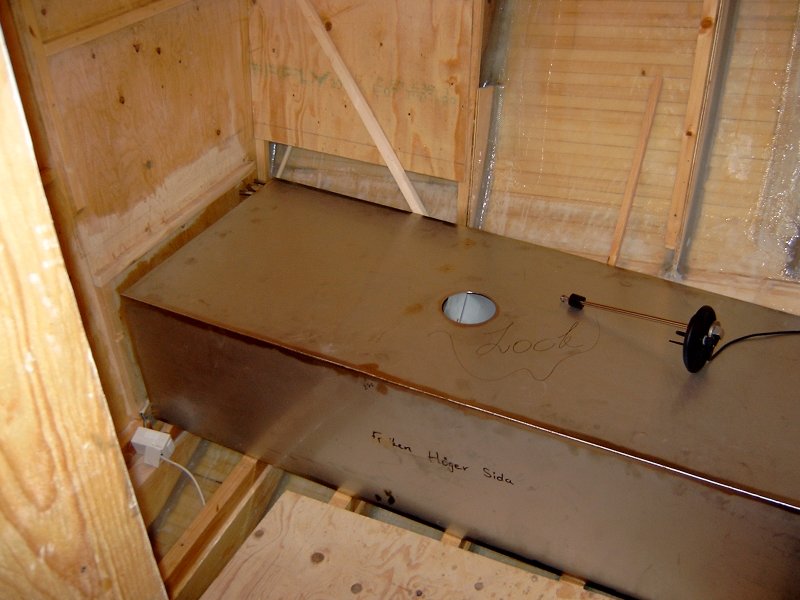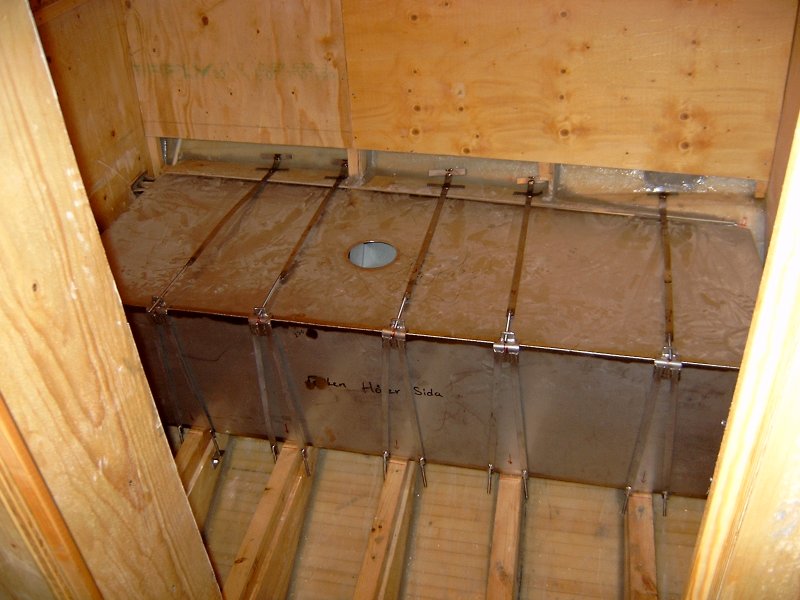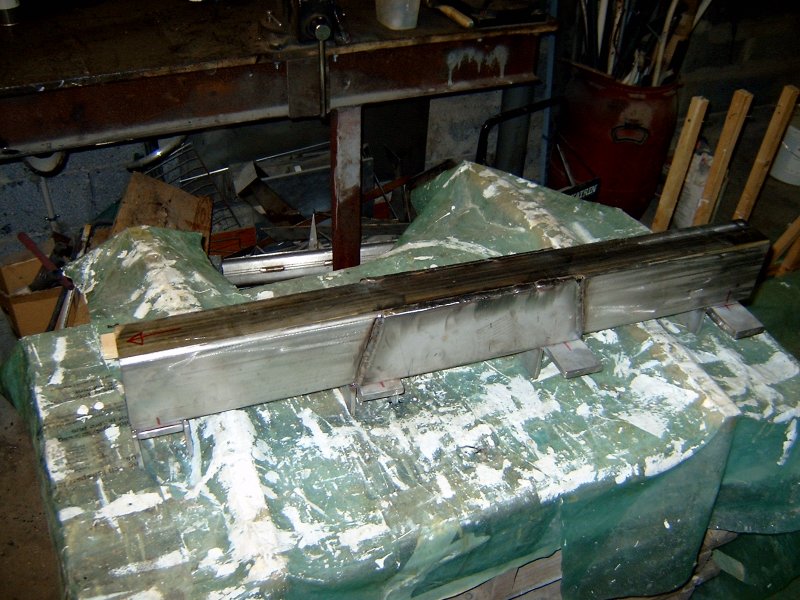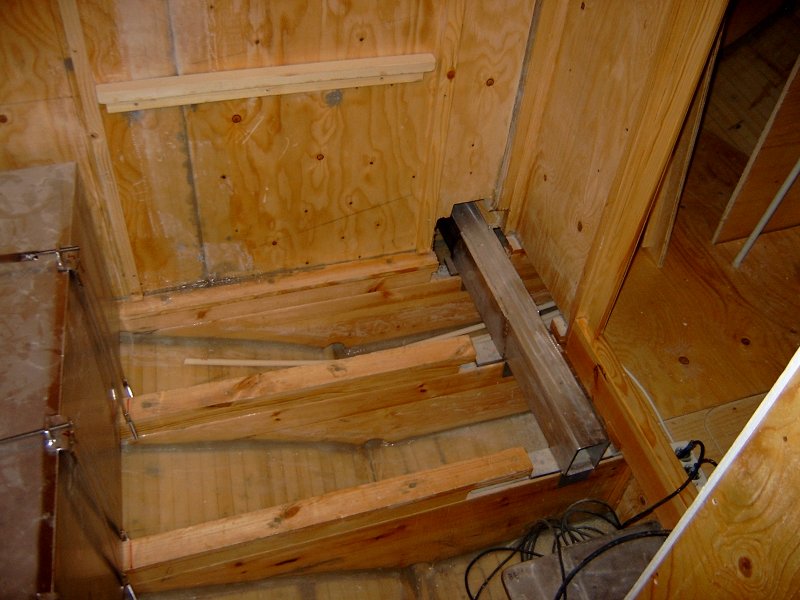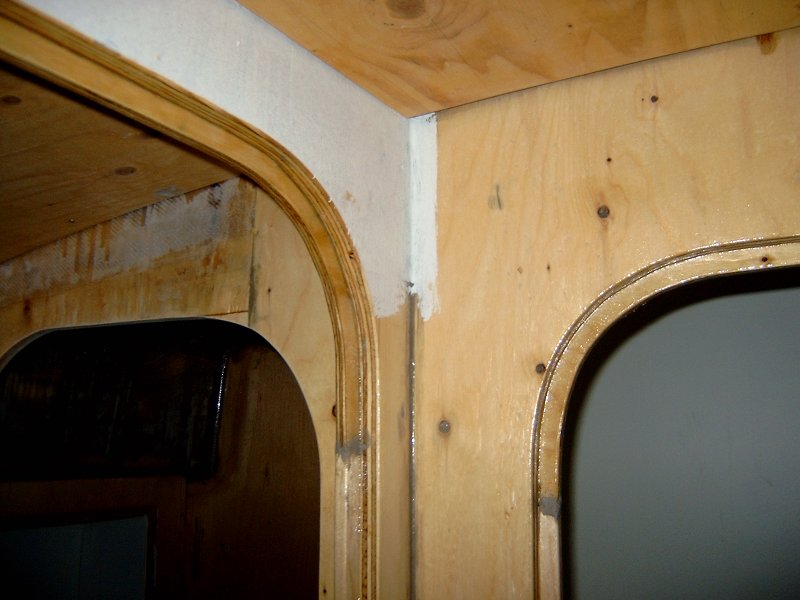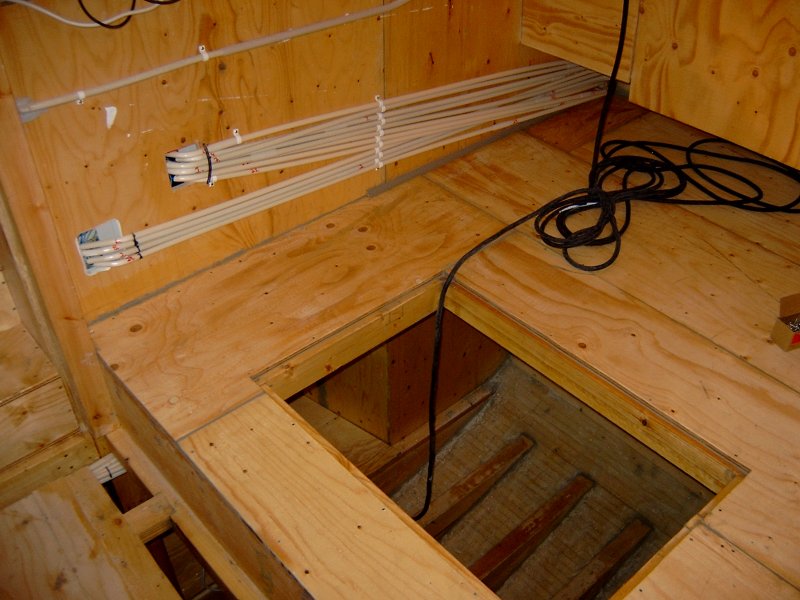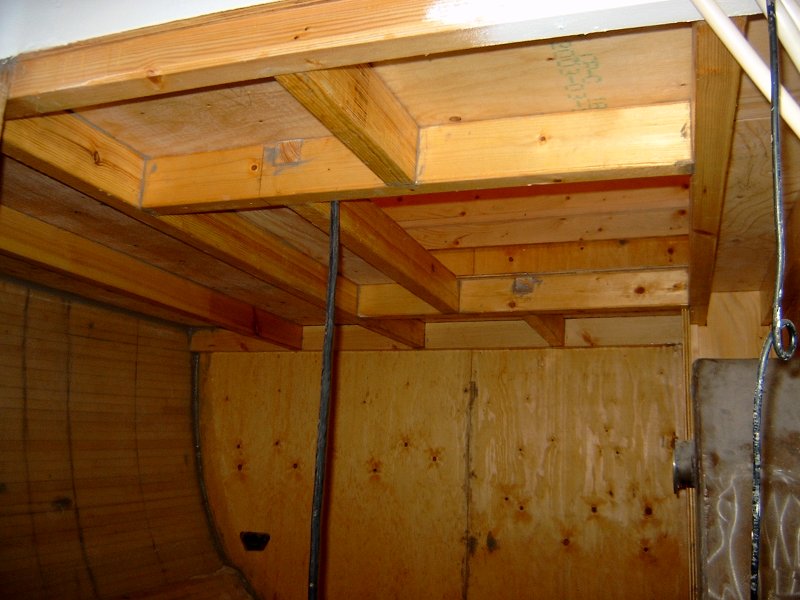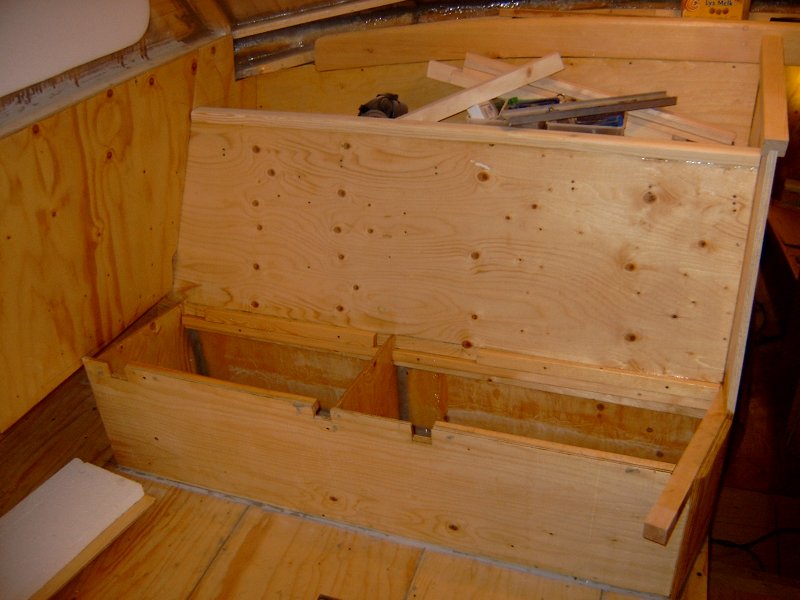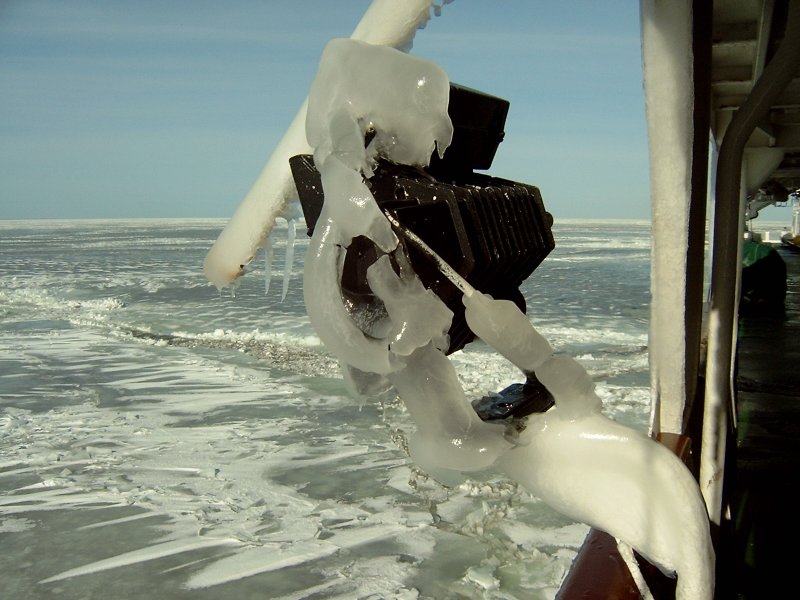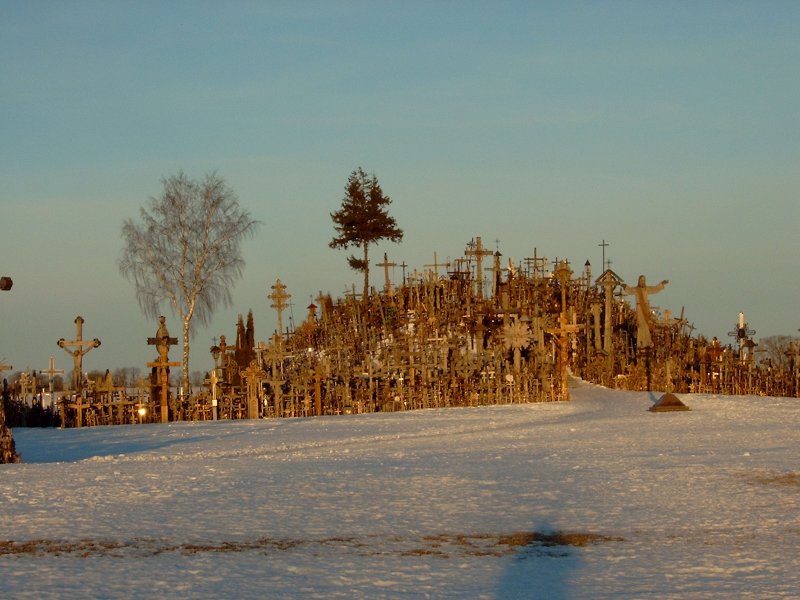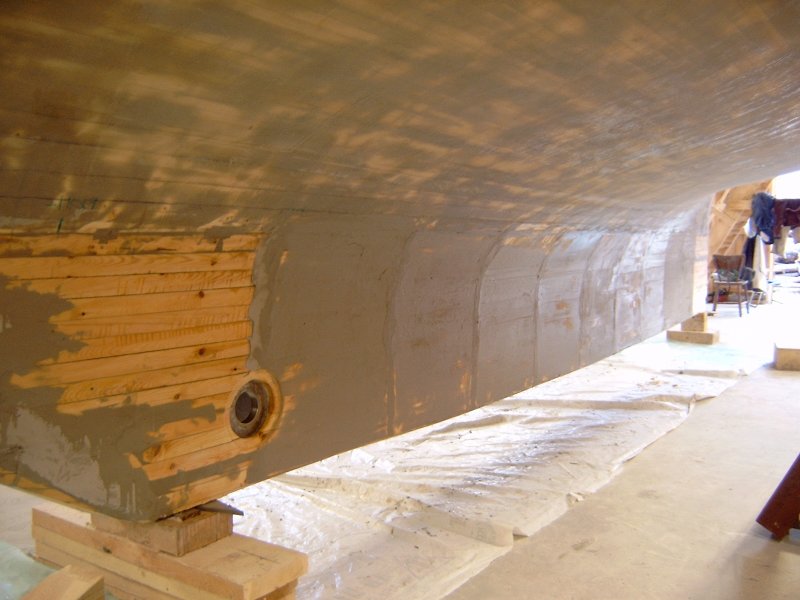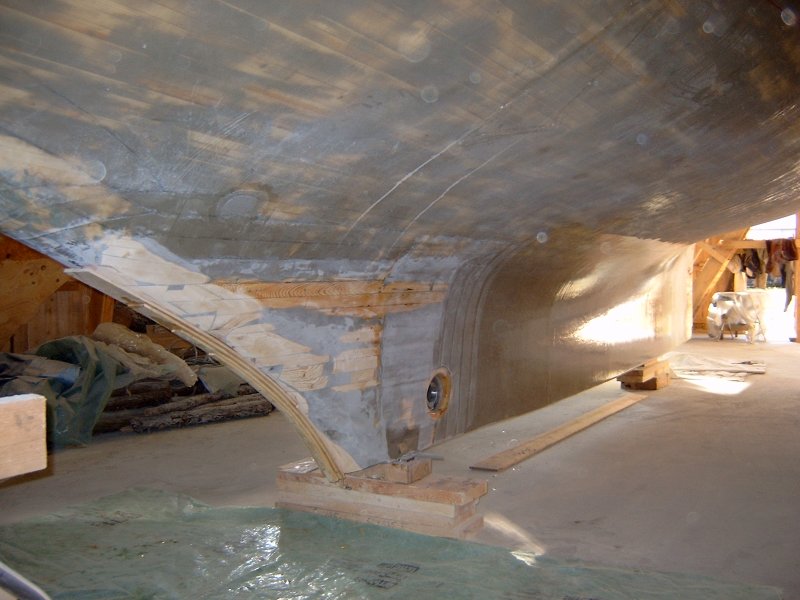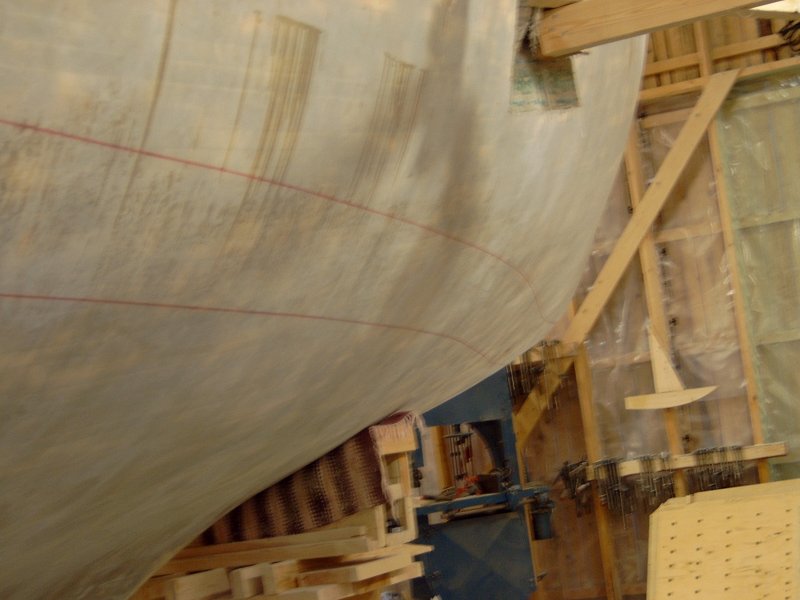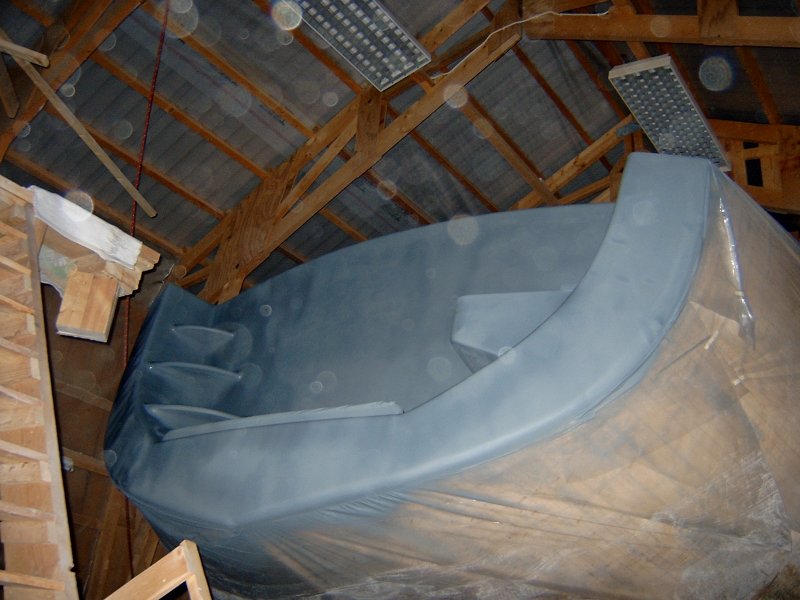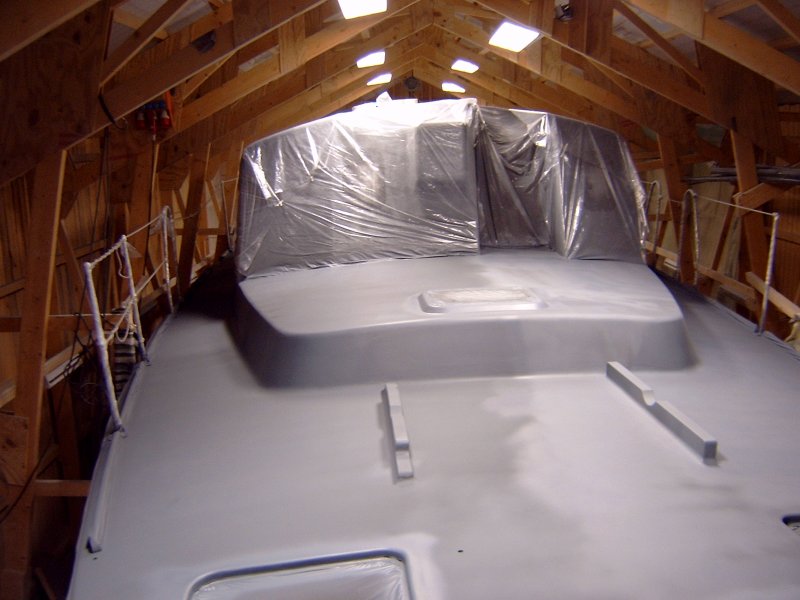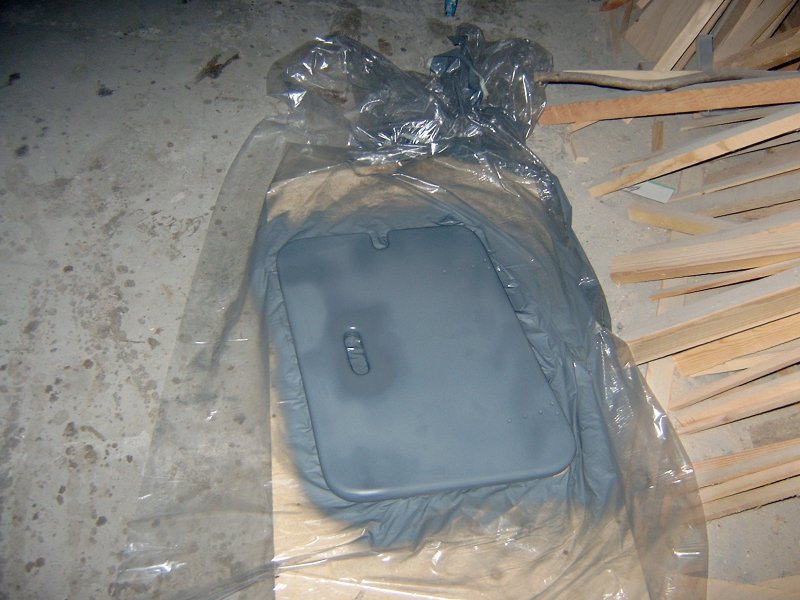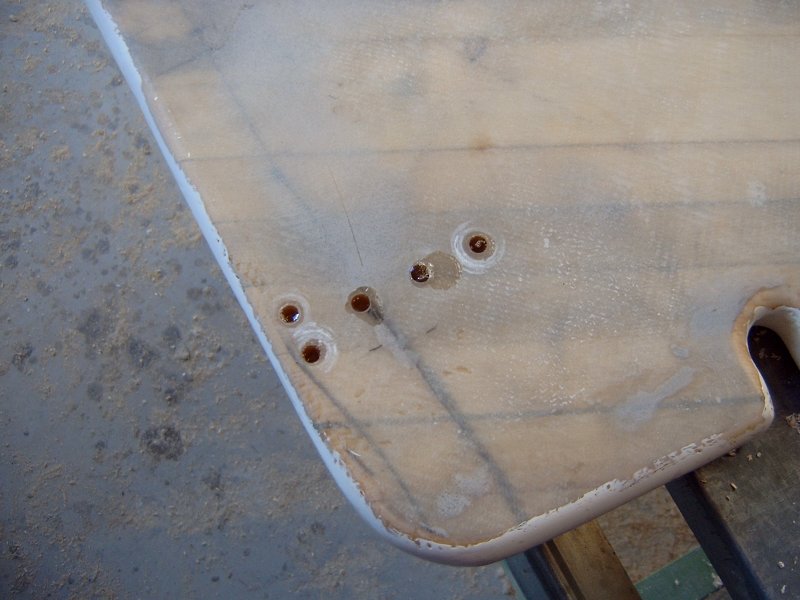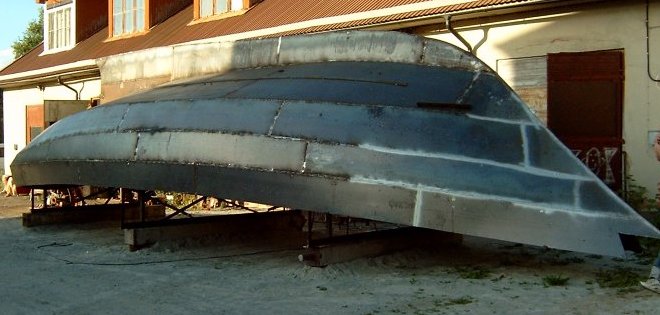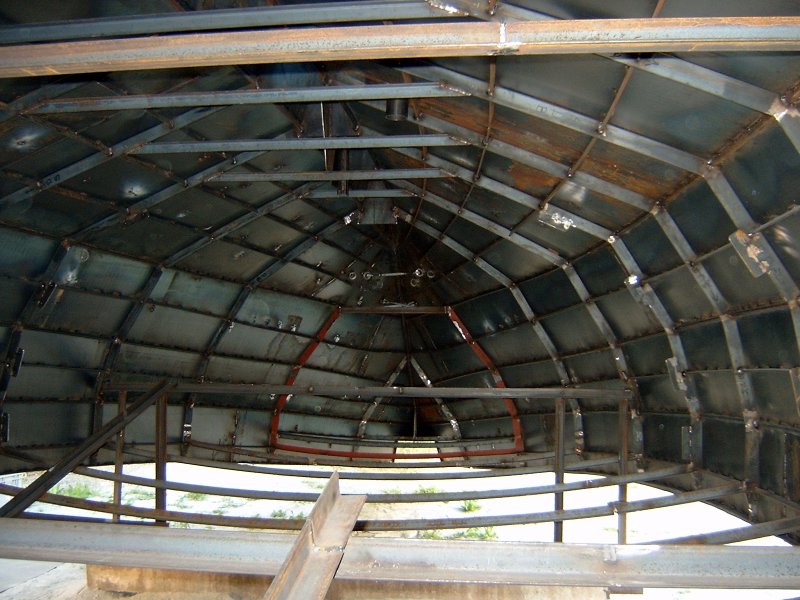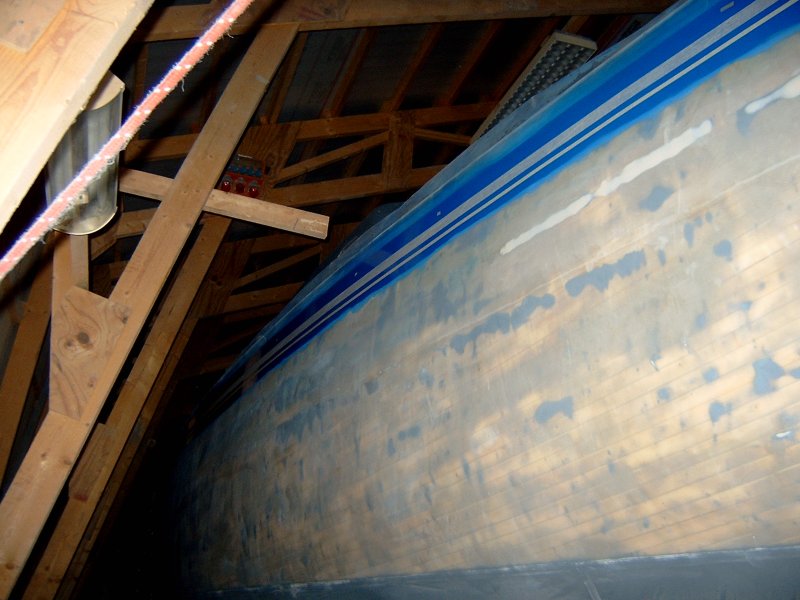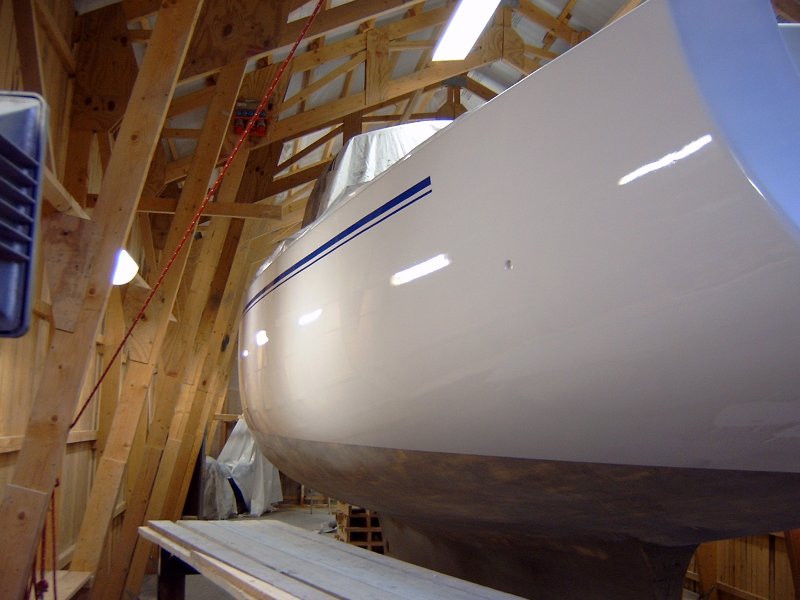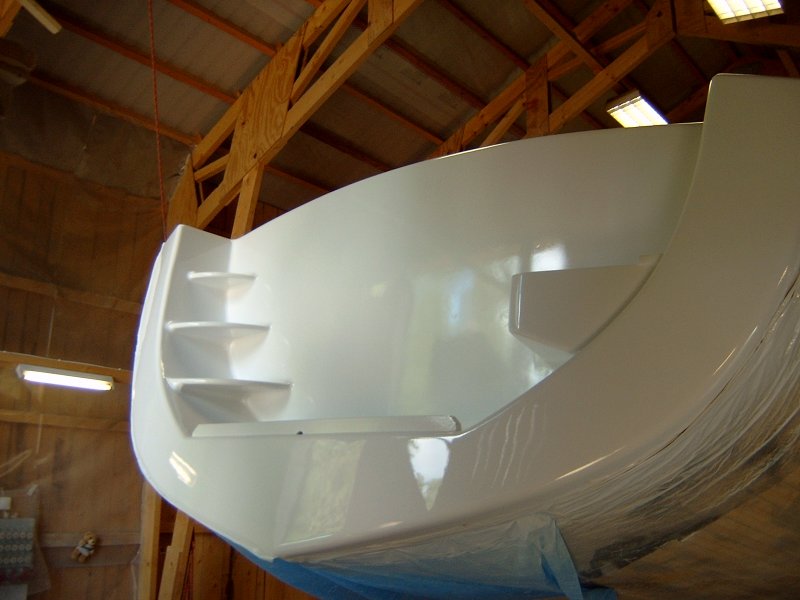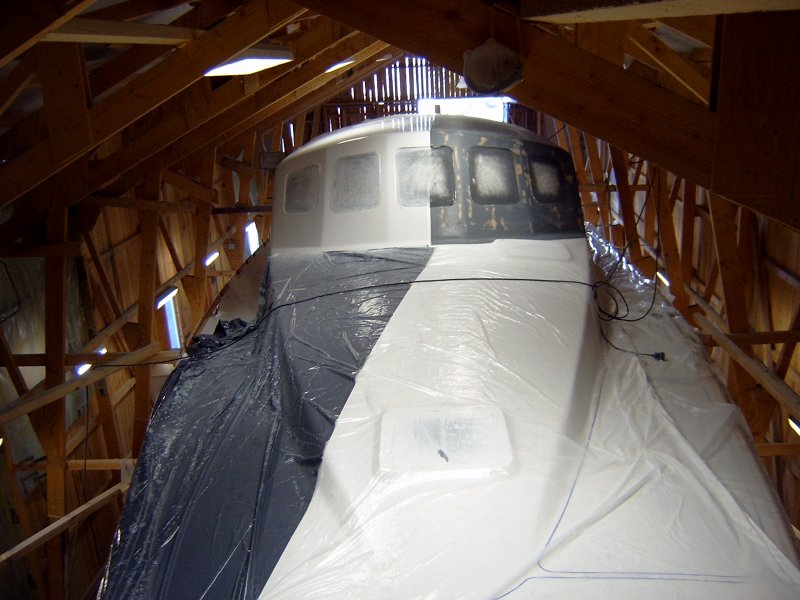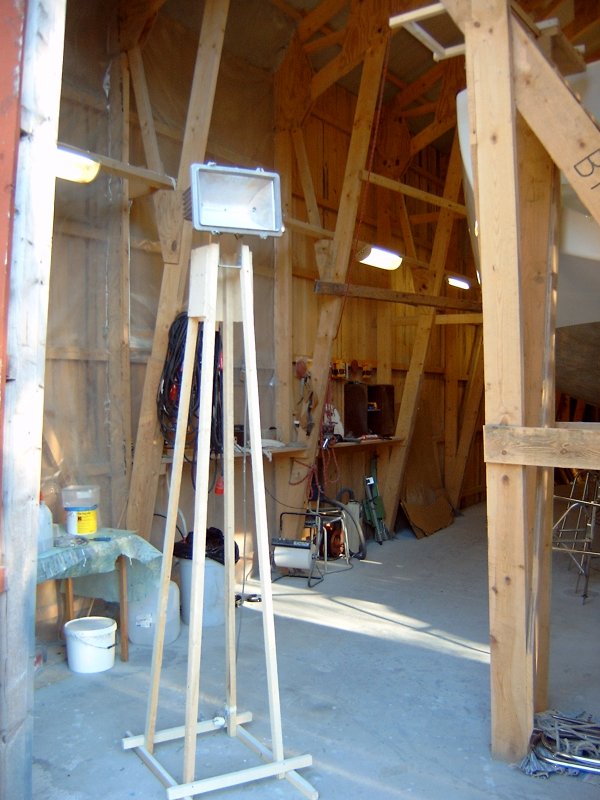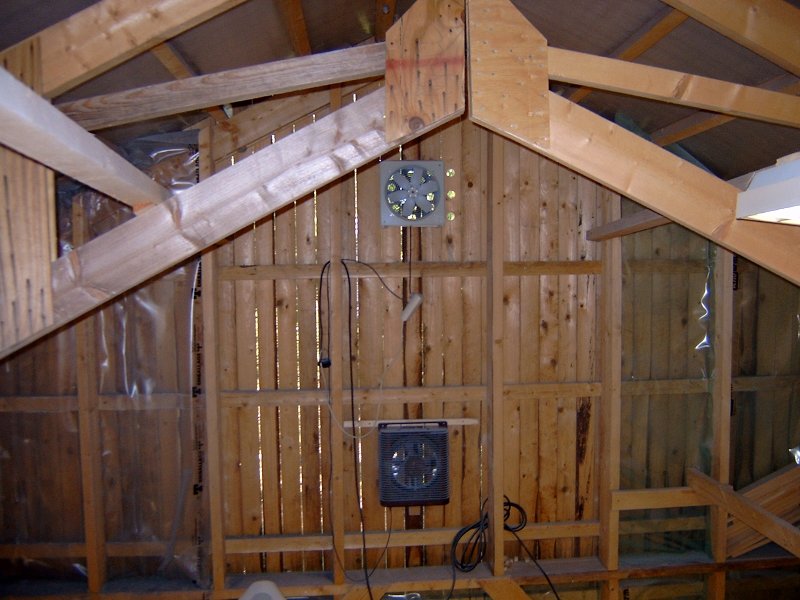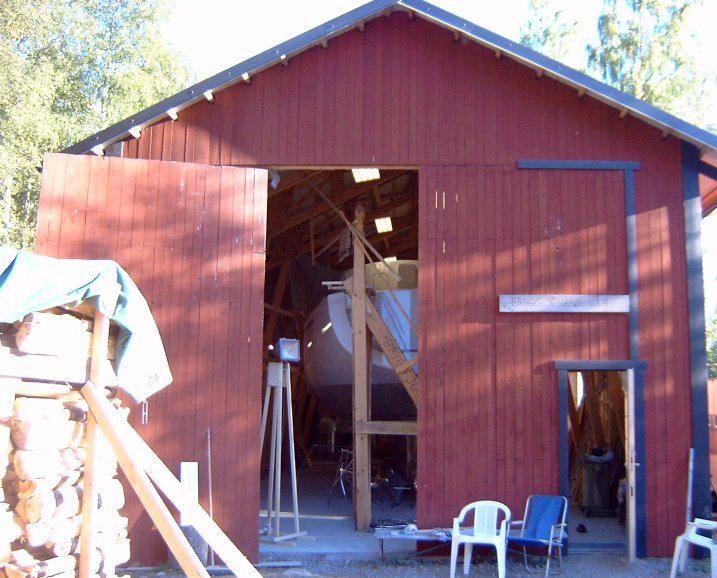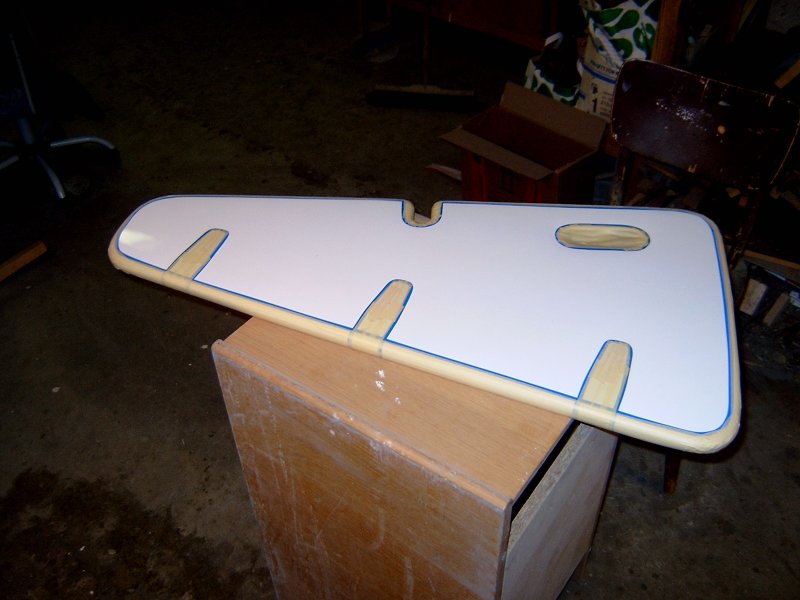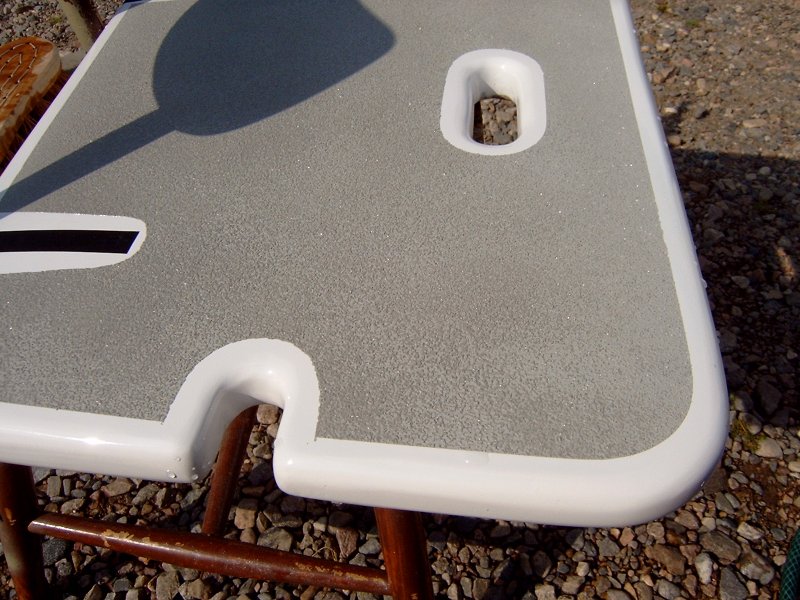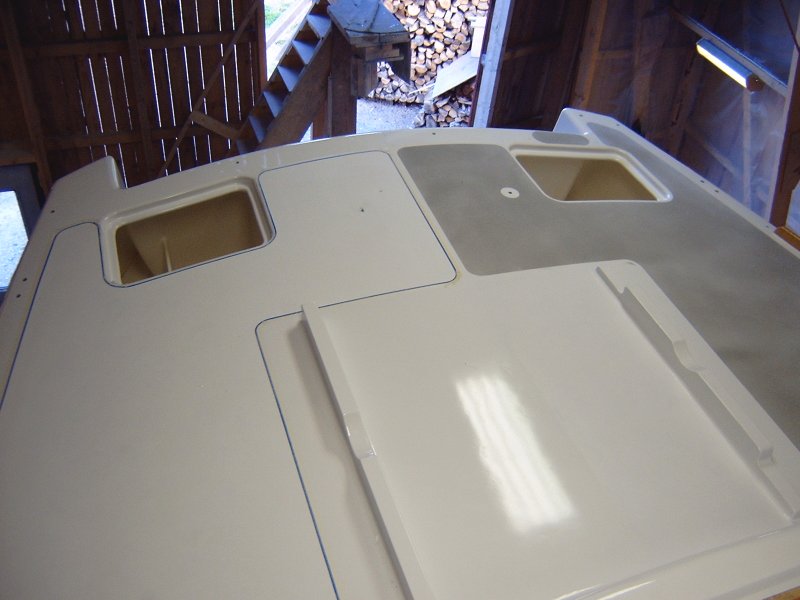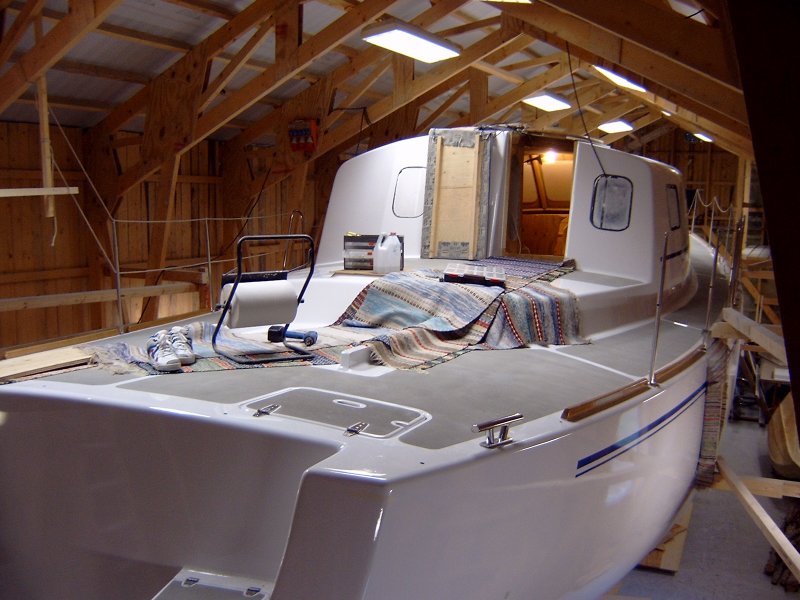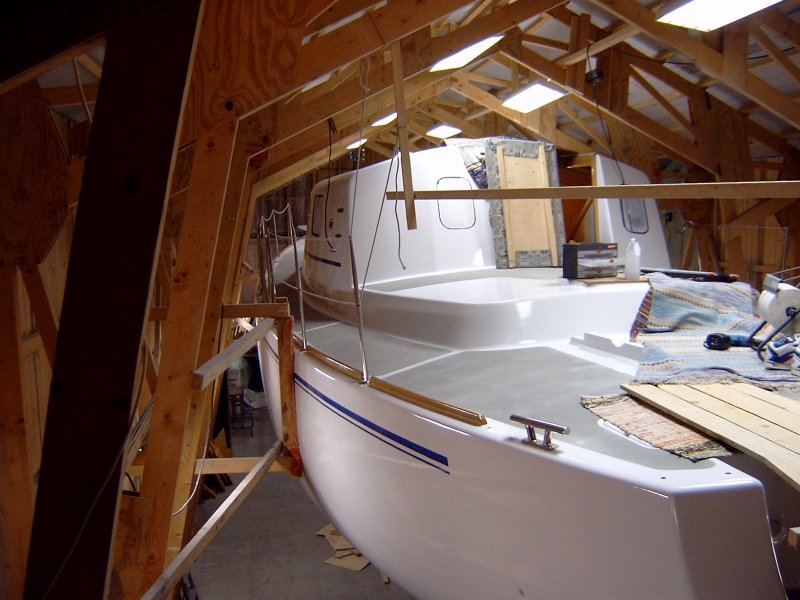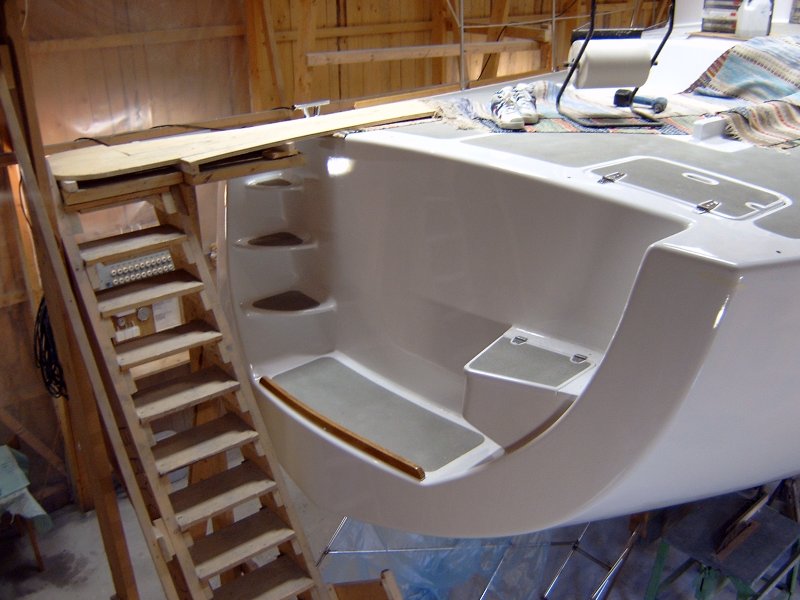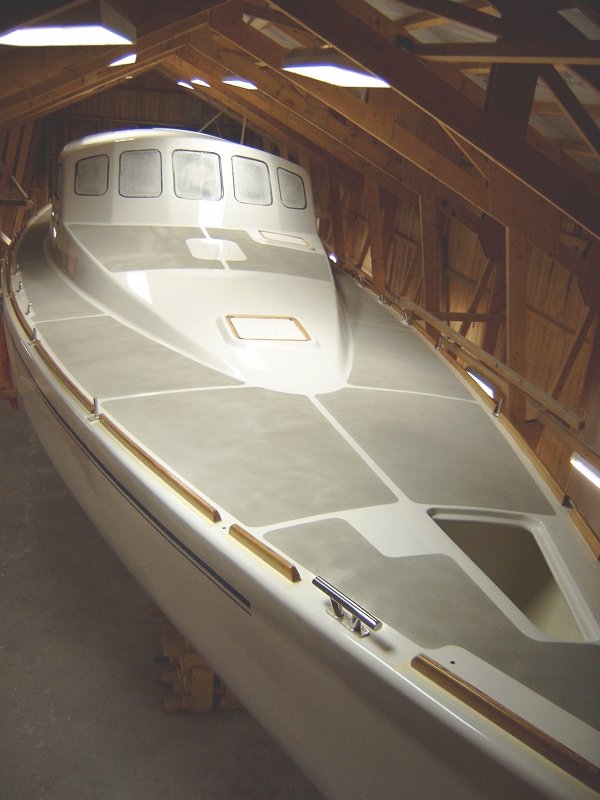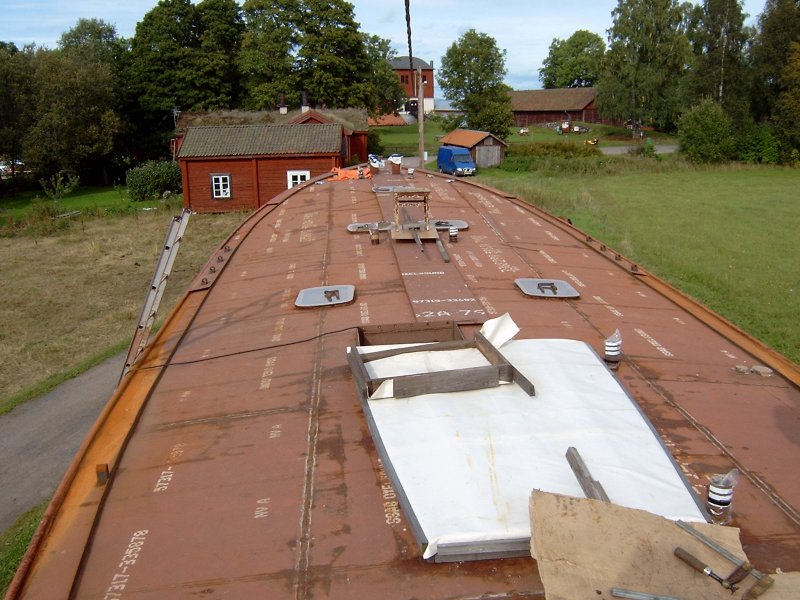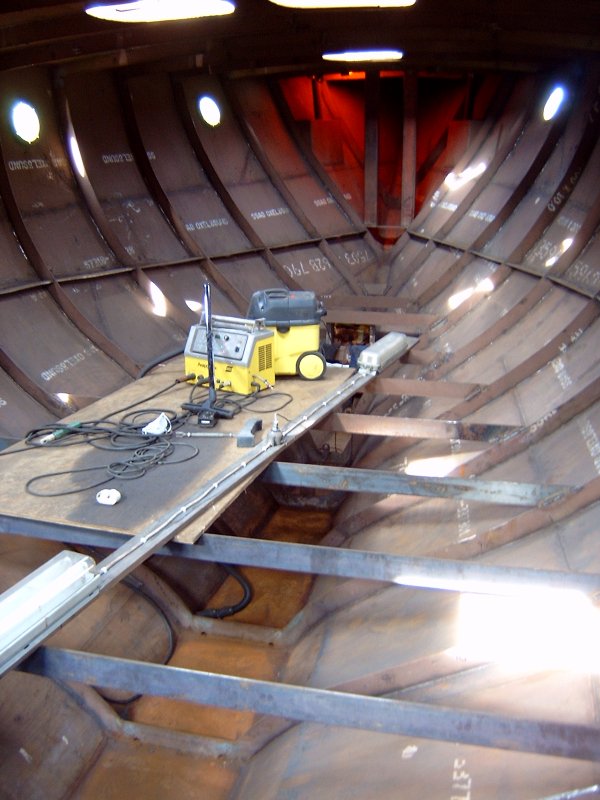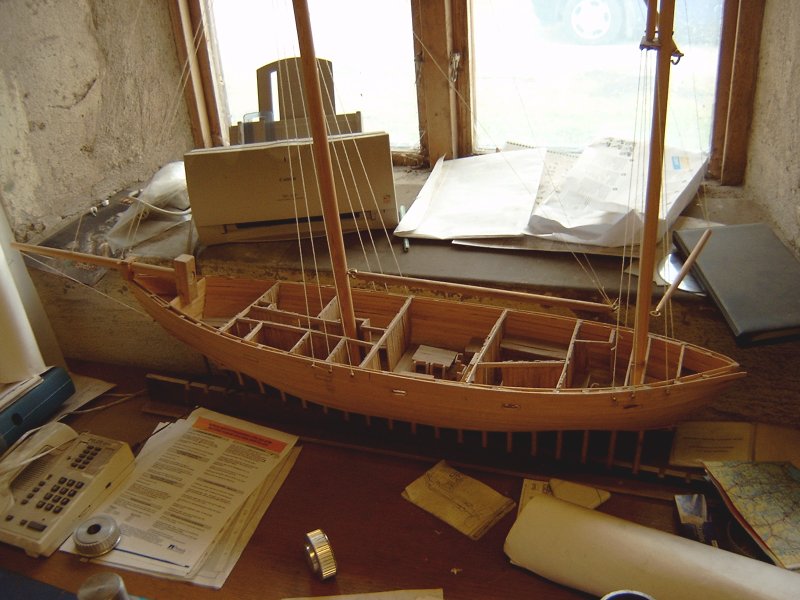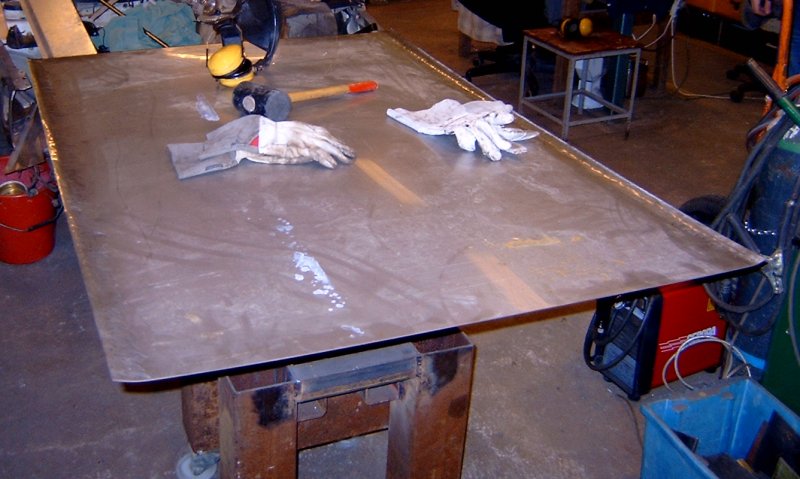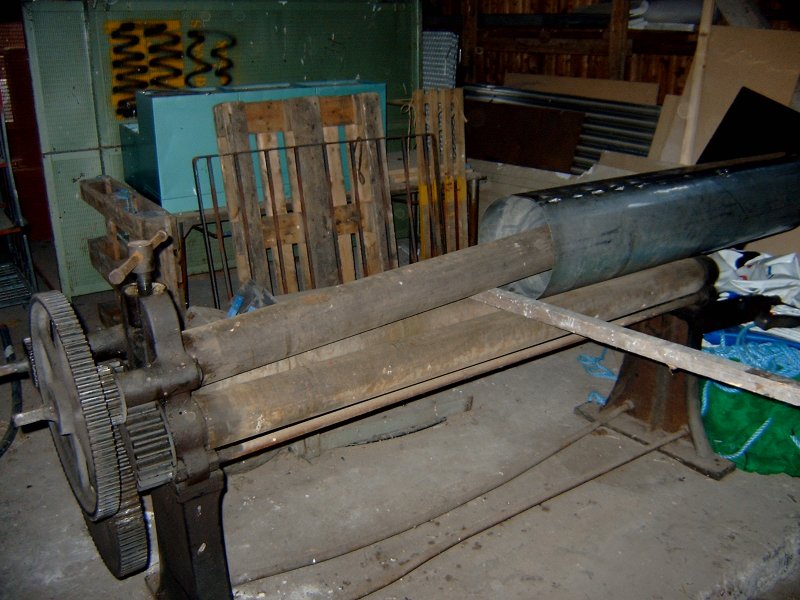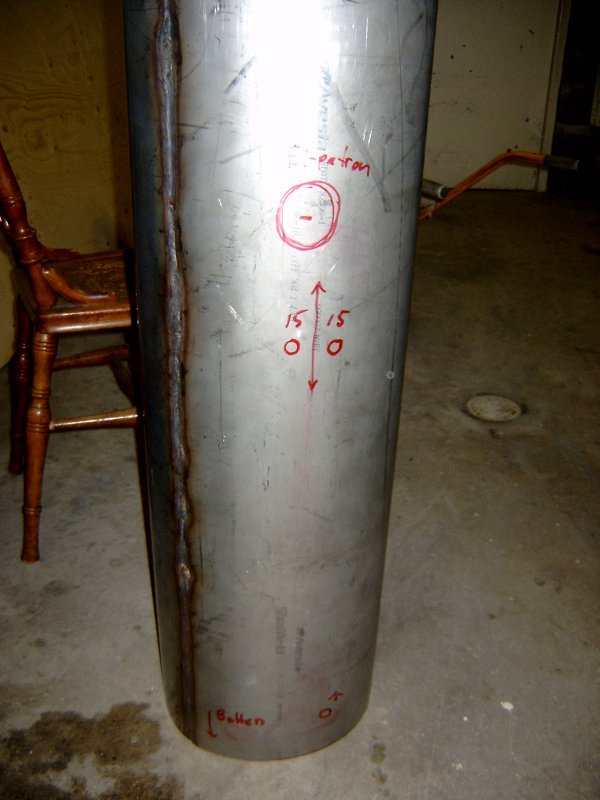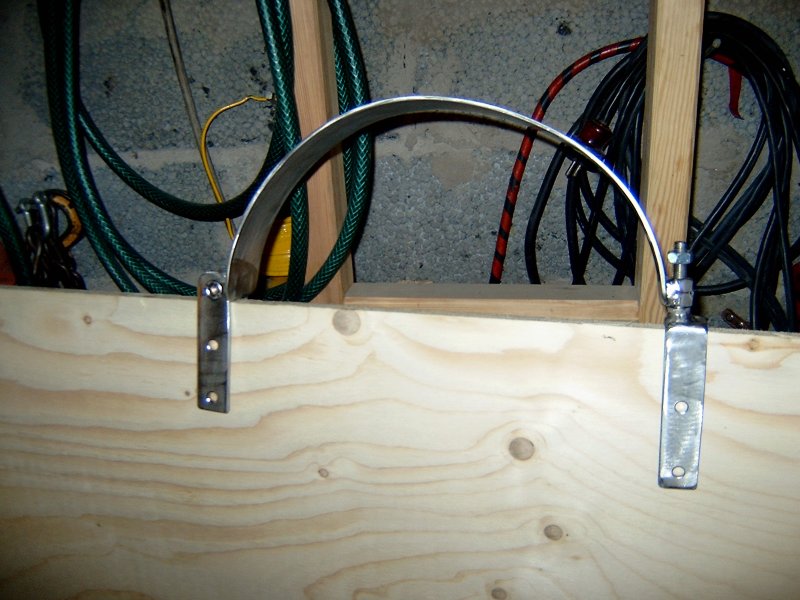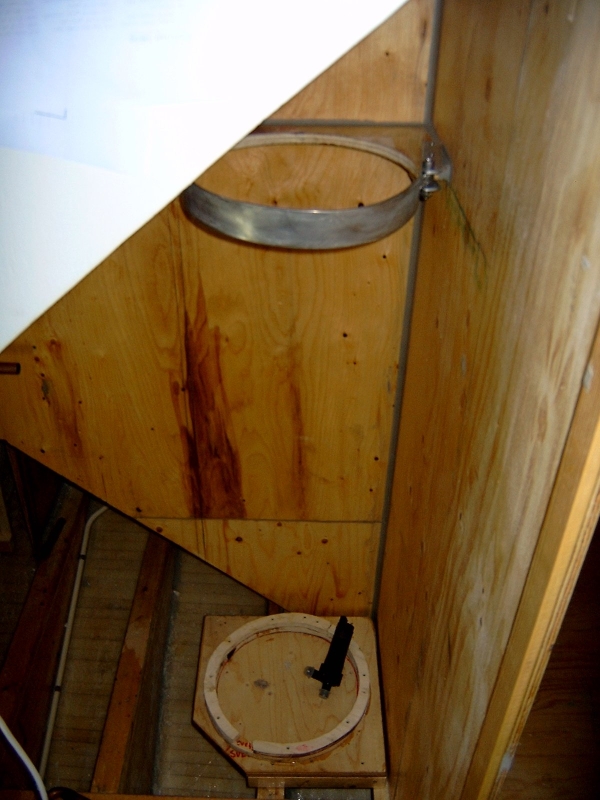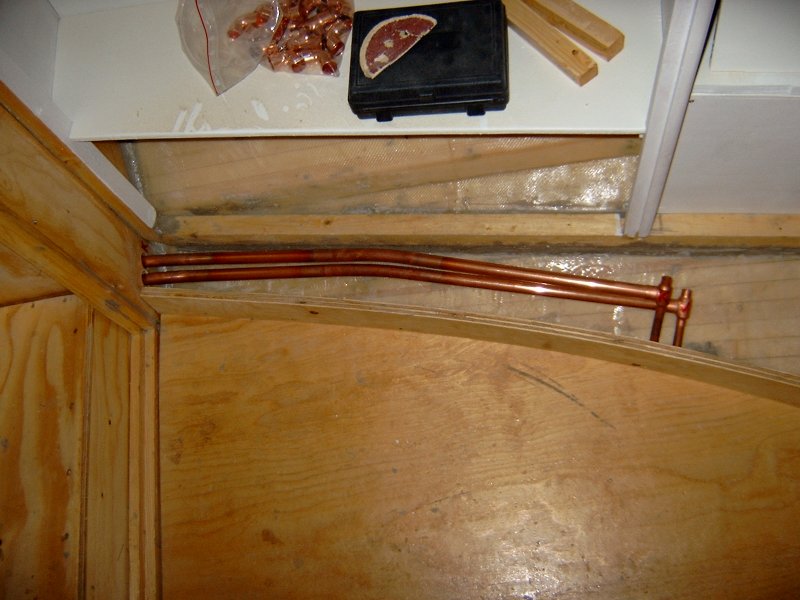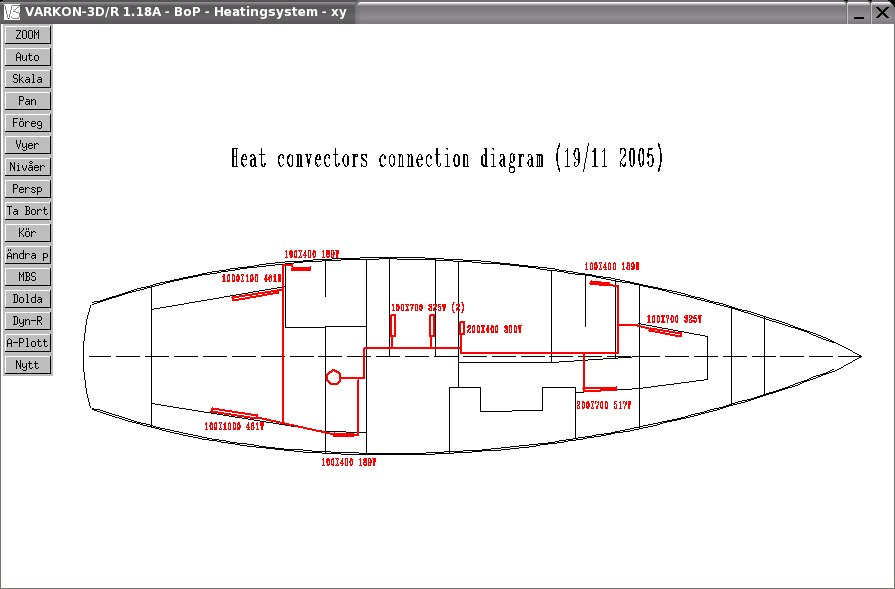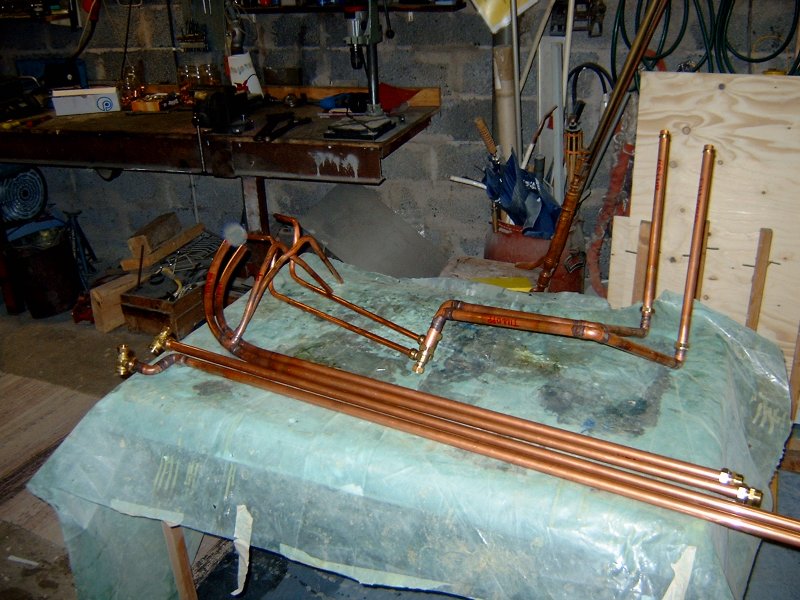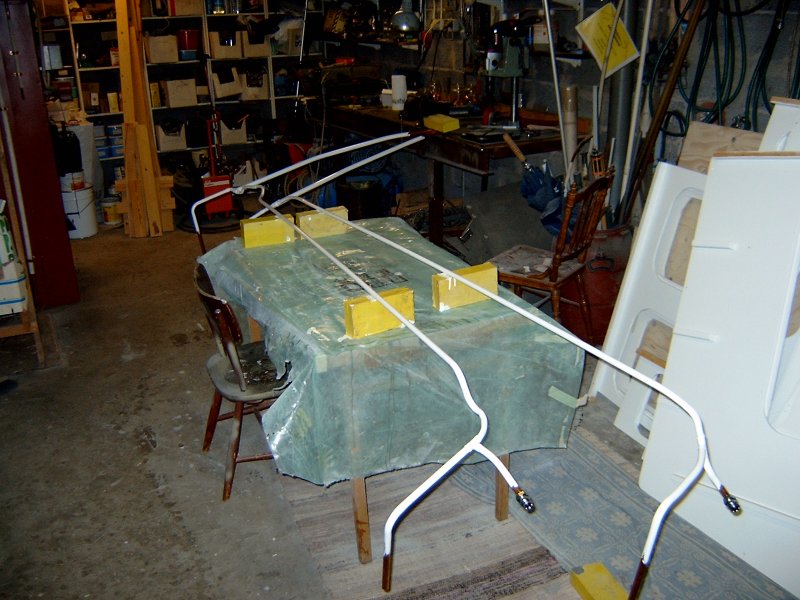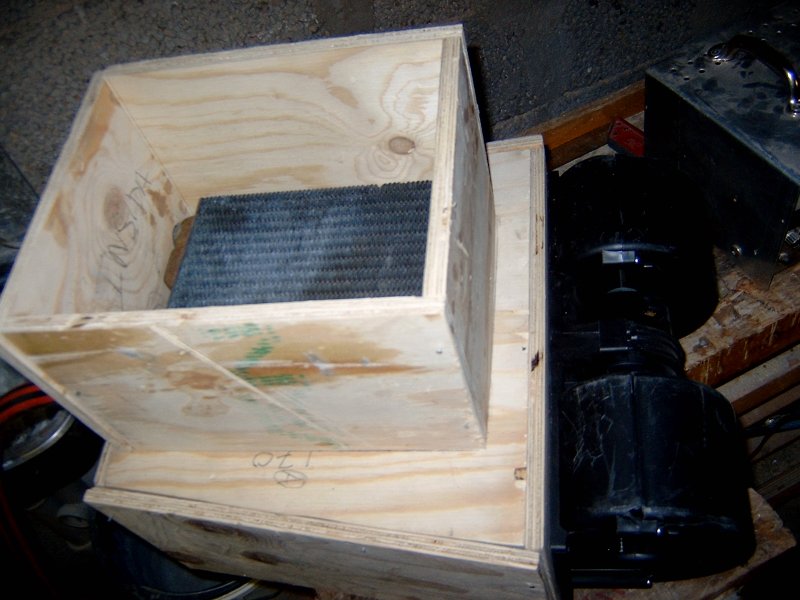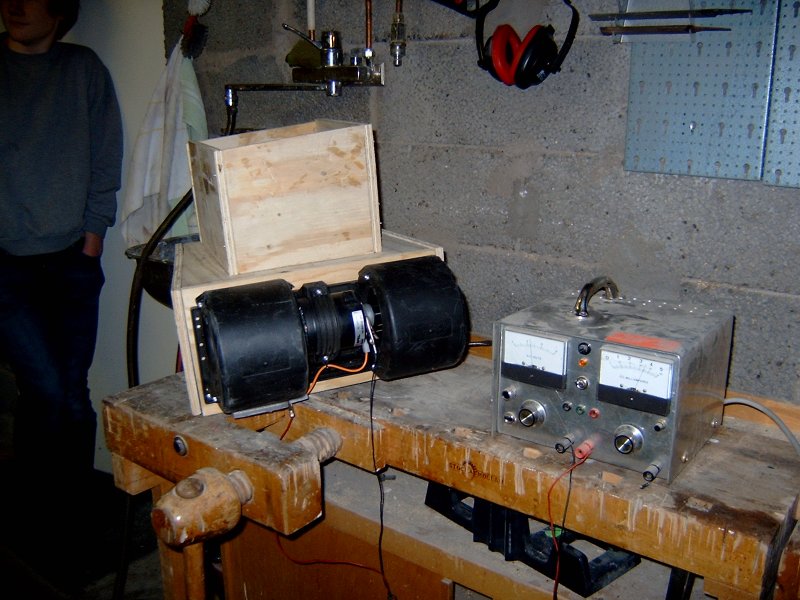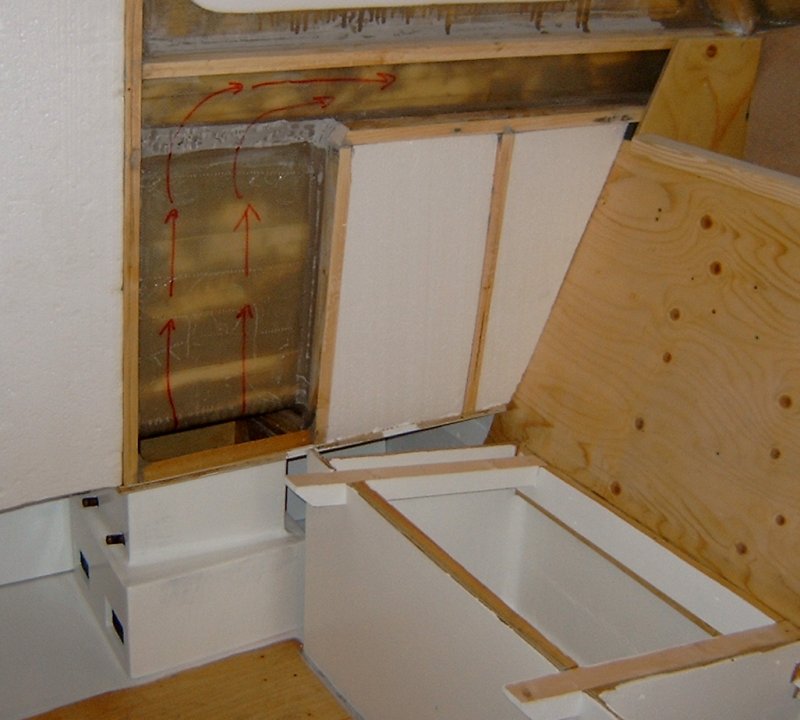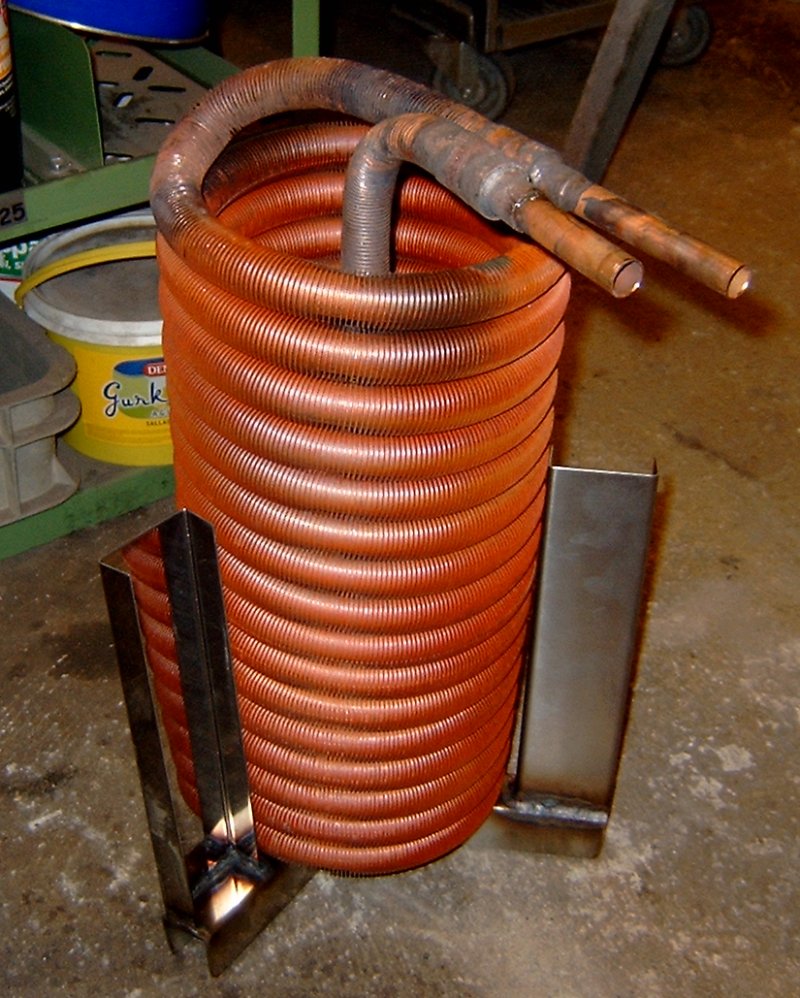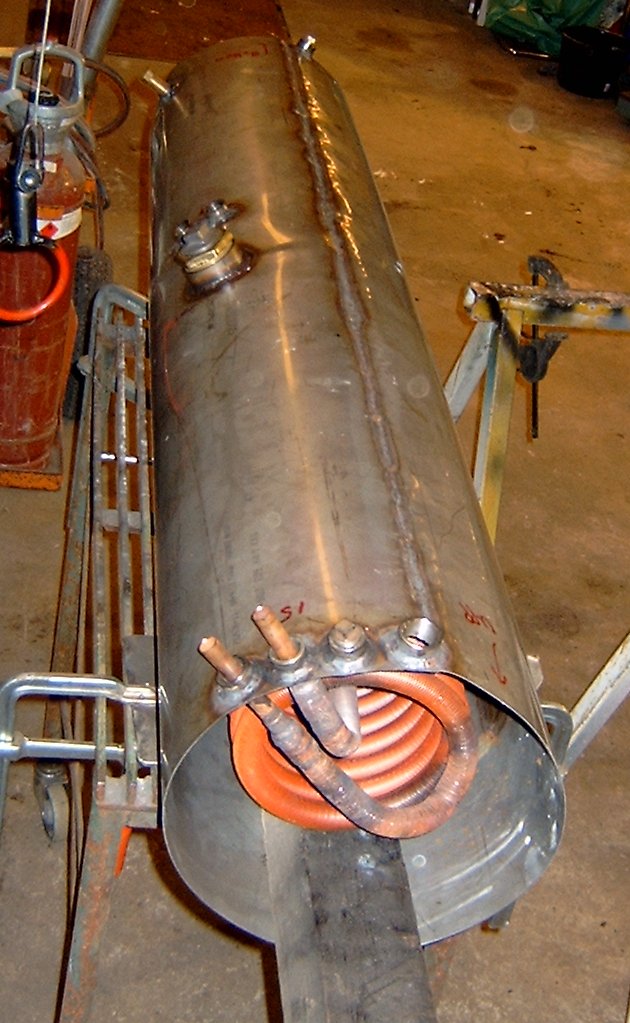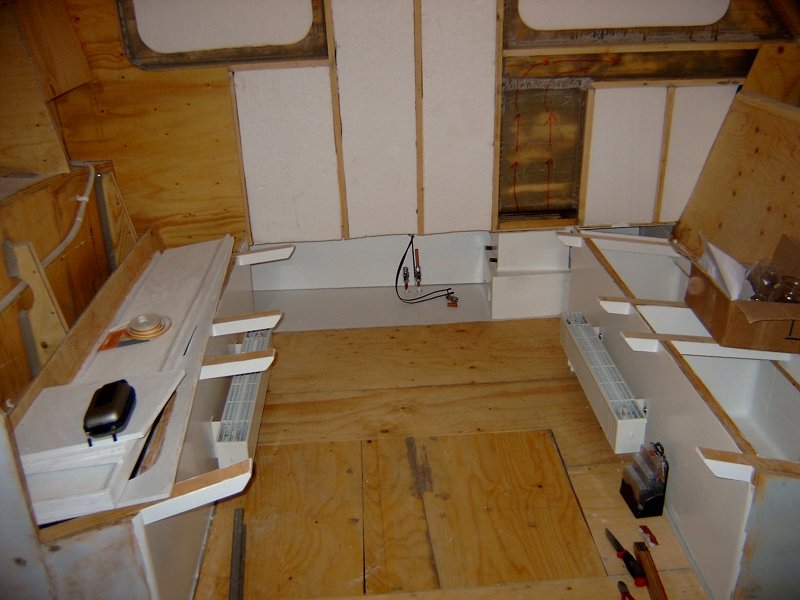
 2005
2005


Painting
by Johan Kjellander 2005, 2014
January-Mars
Time passes quickly. Christmas, new year, snow and winter but I have the heat on in the boat so now I work even when it's cold outside. Most of the really big jobs are done, building the hull, deck, keel and so on. The interior is more like millions of small jobs and a lots of planning and design. For some time now the work has been concentrated to the mid cabin and the galley. The galley needs a lot of storages says Tove so I try to use every space available. The first picture shows the staircase that will lead down to the galley from the deck house. Each step has a hatch with a separate storage. On the two other pictures you can see where the combined fridge/freezer of 165 liters will stay. Above is room for the micro and above the micro is a storage for bread and other dry stuff. To the left will be room for a dishwasher.
Stainless details like hinges and locks are usually quite expensive but God invented Biltema for me so now I purchase these things for less than half the price. To the left is the door to the outside locker where all the tanks will be filled and where the shore electricity goes into the boat. The lock is Biltema for 159 SEK while Watski wants 490 SEK ! To the right you see the shore inlet for electricity already in operation. The inlet is made for 3X400 volts but with a short cable and a one phase plug for 230V I can also use it when 3 phases are not available.
Mould (mögel) can be a problem, specially under a bed. The solution is ventilation. Therefore all beds in Bird of Passage have double bottoms with air ventilation. On this picture you can see how I glue the two pieces of plywood together with thin strips between. Lead weights and a plane floor keeps everything in position. This is the lower bed of the center cabin, named Gustav's cabin, our youngest son.
Under the bed is room for a watertank of 400 liters. I ordered 2 mm stainless sheet metal from Avesta Stainless in Torshälla and made the drawings with the Varkon CAD system. Bista Mekan in Örebro did the cutting and welding. Next weekend I will mount it in Gustav's cabin and then finish the rest. After that there is some job to do in the deck house and then it is summer again !!!
April-May
Work has not proceeded as fast as usual lately. Other things have unexpectedly taken most of the time but now I am back in the boat again. As usual there is lots of smaller jobs while waiting for summer temperatures and for the deadwood in the keel to dry out completely before being sheated with glass and epoxi. Last time I checked, the water content was still 14% which is 2% too much. Maybe I will have to dry it out with an electrical heater.
I have been working with fastenings for the water tank in Gustav's cabin. 400 liters of water is 400 kg's of weight. In bad sea the dynamic forces can be considerable, and with time things might start moving. So, I spent a lot of time, maybe too much, to construct strong fastenings.
Another job in Gustav's cabin is the mast support. To spread the load I made this beam from stainless steel that rests on 4 floors and takes the load from the mast down into the keel plank and the hull.
I have also spent some time with preparations for doors inside. There will be 6 doors, and each one is a little different. Each opening needs a frame for the door to close nicely.
Another job which is now finished is the floor in the deck saloon. There will be two hatches, one for each motor. The picture to the right shows the forward sofa which is almost finished. It houses two storage compartments that will be used for bed ware when the sofa is not used as a bed.
We spent the easter holiday to visit friends in Lithuania. We took our minibus to Stockholm, then the ferryboat to Riga. It was still winter and lots of ice on the Baltic. The sound when the ship went into the ice was astonishing ! We continued with the minibus to our friends in Radivilskis, close to the famus religous place of Cross Hill. We also visited Kaunas where I held a lecture at the Technical university and Tove visited the library. In Vilnius we spent three days with visits to the national library, the television tower and the KGB museum. Then we saw the old town of Trakai and the port of Klaipeda with the best sand beaches in the Baltic. Lithuania is old and modern.
June-July
Summer and time for outside work. There are two things I want to do this summer. 1-finish the job with the fixed keel deadwood and 2-paint the hull sides and the deck. The deadwood to the fixed part of the keel was glued into position last year so now it's time to sand, add filler to get the right shape and coat with glass fiber and epoxy. The left picture shows the deadwood partly coated with filler and the right picture shows what it looked like when most of the deadwood was covered with 4 layers of glass and only the front part remained to be done.
Painting the outside of the boat may sound as a quick and easy job but the preparations before actually applying the final coat of paint are very time consuming. First of all I marked the waterline with a red pencil. I then made a new line 200 millimeters higher up. My estimate is that this line with the boat fully loaded and lying still with normal movement that may occur in a harbor will stay above the water most of the time. Under this line I will only have anti fouling. This picture shows the waterline and the new line at WL+200 at the front part of the hull. We decided to go for a white color (RAL 9003) polyurethane above the line at WL+200 and also for the deck and superstructure. A blue line (RAL 5010) will be added 150 millimeters under the sheer line and the deck will have parts of it coated with anti skid in a gray color (RAL 7038).
Next I sanded all surfaces above the WL+200 line with 40 and 120 grit paper. Then, I put on a thick coat of filling primer and sanded again with 120 grit paper. After that there were still small places that needed filler. More sanding and then a second coat of primer and then sanding again with 120 grit paper. After this job the surface was acceptable as far as I could see. I then sanded very lightly a final time with 180 grit paper. All this job took most of June and July to finish !!! I hope to be able to show pictures of the boat painted a few weeks from now. Here are some pictures showing what it looks like after spraying one coat of primer. The stern, the aft deck and a hatch for one of the anchor boxes.
There will be many holes through the deck for fastenings of different kinds. Hinges for hatches is one example. To protect the wood from water coming in through these holes I first drilled larger holes, then filled them with epoxy then drilled the 4 millimeter hole for the screw through the epoxy.
An old friend of mine is building a Roberts Spray 36 in steel. I visited him a few days ago and took some pictures. To the left is a picture showing the outside of the hull still upside down and to the right is a picture from inside looking forward. He's a very good mechanic and the job he does is very professional. This Spray will be a beautiful boat when it's finished !
August
Final painting started in August and continued until the second week in September ! First one side of the hull, white with blue lines, then the next, then the stern, then
I was lucky with the weather. August and September can be cold but this year the temperature went up to 20 or more almost every day. A lower temperature means the paint needs more time to cure and increases the risk of the paint starting to move, specially on vertical or sloping surfaces like the hull sides. More than 50 liters of primer and paint was used and 30 liters of acetone for cleaning. I bought 50 liters of acetone earlier this year very cheap from a shop in Örebro that was closing down.
Good light is important. I used a 1500 watt halogen lamp ! That helped a lot. Good ventilation is also important. I installed two fans in one of the gable walls of the boat house and opened the other gable. The result was a steady stream of air along the length of the boat that very effectively removed all vapors in short time. A breathing mask with coal filter is also needed of course.
I bought a few rolls of tape and plastic film before I started but I soon had to bye more. I used more than 25 rolls of tape I think and at least 500 square meters of plastic film ! The cost of all material needed for painting, including primer, paint, sandpaper, tape, plastic film, acetone etc. ended at approximately 20.000 SEK.
September
With the boat coated in white it was time for the anti skid pattern on the deck. This is an interesting issue. I spent a lot of time investigating different methods and finally found something I liked on the newsgroup rec.boats.building. This is how it works: First you draw up the contours of the places on the deck where you want to have the anti skid treatment applied. I used an ordinary lead pencil. This is practical because you can easily erase any mistakes with a rubber. Then you apply a thin stripe tape along the outside of the lines. After that you can use a wider tape and plastic film to protect all areas you want to remain white. To the left below is a picture showing the hatch to the forward anchor box with tape applied.
After light sanding with 180 grit paper you apply a first layer of paint and let it dry for a few hours. I decided to use a light gray color (RAL 7038) of the same type as the white paint (Standox polyurethane). You then add a second layer of the same paint and immediately after you sprinkle ordinary sugar into the wet paint. I made a shaker by drilling millions of 2 millimeter holes in the bottom of an empty plastic bottle. Next day when the paint is dry you clean the surface with water. The sugar melts with the water and goes away. And voila, left is a very nice looking anti skid surface ! This method has many variations, you can also use sand, micro balloons or a variety of other materials but these will stay in the paint of course and may need additional coats of paint in order to become comfortable. The sugar method creates a surface which has very good grip and still is friendly to your skin.
Pictures from painting the aft part of the boat.
Here is the stern and a nice picture showing Bird of Passage from forward. I'm very happy with the result.
I also have had time to visit another building project. This boat is a steel version of a large Colin Archer. The original drawings have been modified to make the boat longer so the length is now close to 20 meters. It's a heavy one, 20 tons of ballast in the keel and a total displacement of 60 tons when the boat is finished ! To the right is a wooden model where you can also see the plans for the interior layout. It's a very professional job, and the result will be fantastic. If you compare this boat with Bird of Passage, space inside is more or less equal, both boats have long deep keels and similar rig size but Bird of Passage has a displacement of only 25% of the Colin Archer !
October
Now it's cold again. I don't like it. It's definitely time to get the Bird finished and head south ! A temporary solution is to install a heating system. Said and done, I started the actual design of the heating system a long time ago but now its time for reality. The heart of the system will be an accumulator tank with a volume of 120 liters. The water in the tank will be heated by three different sources. First of all is one of the engines, next is an electric heater and finally a dedicated diesel heater that can be used when resting somewhere where there is no shore connection for electricity. A tank like that is not possible to bye so, as usual, you have to make it yourself. I started with a piece of stainless steel sheet metal. An old friend of mine helped me, we bent the edges a little using a rubber hammer and then we rolled the metal in an old rolling machine.
After welding the edges together using his TIG-equipment I marked the positions of all connections with a red pencil. A tank of 120 liters, 1.5 meters high needs good fastenings. I made the metal clamp above to secure the tank properly. The picture to the right shows the clamp in position together with the lower fastening in the machineroom.
While the tank is being finished I have now started working inside the boat with the tubing for the radiators. There will be 10 convector radiators, each fed by a copper tube with another tube returning the cooled water to the tank. I ordered the convectors from Swedish Thermopamel AB, complete with thermostats, connections and fastenings. Check ThermoCon on http://www.thermopanel.se. The picture to the right shows the overall layout of the heating system. I hope to be able to fill the system with water in January.
November
Work with the heating system continues, mostly work with tubing. 25 meters of 22 mm diameter copper tubes and 15 meters of 15 mm diameter. Short pieces of rubber (EPDM) tubes here and there to take up movements from heat and vibrations. Convectors will arrive in a week or so and the accumulator tank still has some time before it is finished. A 3X400 Volt 3 kW electric heating element with thermostat has been purchased. Most of the material comes from Rinkaby Rör. Good prices, Internet shopping and delivery at the door of the boathouse within a few days.
Insurance is an interesting issue when you build a boat yourself. When the project started I contacted Länsförsäkringar, the insurance company where our house is insured. They offered a relatively cheap insurance which I payed for during the first years. A year ago I had an official from the Swedish Maritime Authority to inspect the boat and he wrote a protocol which stated that the value of the boat was at least 1 million SEK at that time. The insurance company has a top limit of 500.000 SEK so i then terminated the insurance and contacted other insurance companies to get something in replace. This showed to be an interesting experience. All of the companies I contacted (Alandia, Svenska Sjö and others) were very happy to offer me an insurance which included everything that you would want to have if the boat was in the water, sinking, broken rig, theft and protection for 3:rd party etc. etc. and the prices were thereafter. None of these disasters are however likely to appear as long as the boat is in the boathouse 30 km's from the future place of launching. The only thing I worry for is fire and that's all I'm interested in paying for. If I had some farming equipment worth a million, like a new tractor or something, standing in the boathouse, my old insurance company would gladly give me an insurance for that and it would not be expensive. Now it happens to be a boat and for some reason which I can't figure they are not interested.
Finally I came across a company named Atlantica and asked them for a fire insurance only. They said they could offer me a special insurance for a boat on land including fire and theft with a self risk of only 5.000 SEK. The price would be slightly over 5.000 SEK/year. I then asked them again for an insurance with only protection for fire and this time they offered me a new special insurance with only fire ! The price was now approaching 4.000 SEK/year. I then asked them if they could increase the self risk value above 5.000 SEK. 5000 is a very low value for the loss an object worth one million. They then offered me a third special insurance with a self risk of 10.000 and now the price was 3.800:-/year. I accepted that. I think it's the best I can do at the moment. The story shows how important it is to contact as many companies as possible and don't accept their first offer.
In order to make the deal more official I also contacted the Swedish Ships Registry to get the boat properly registered and a call sign assigned to it. This was quick and simple, I sent them a copy of the main drawing, a copy of the inspection protocol from last year and a paper stating my name and nationality (personbevis). After a few days I received the registration paper and Bird of Passage is now officially existing as a ship under construction owned by Swedish citizen Johan Kjellander and with the call sign SLWP. I will now notify my insurance company about this so that they can enter the call sign on the insurance paper. I will also contact the Swedish radio authority to register SLWP as my official call sign for VHF and SSB radio.
A lot of paper work but very satisfying. We now officially have a boat again (our last boat was sold 1999), it's insured and even has a call sign.
Bird of Passage SLWP
December
The heating system will be one of the best in the world but it takes some time to finish. A lot of tubes need to be cut, bent and painted before the convectors can be connected.
I also decided to add a defroster to keep the windows in the deck house clean when outside temperature falls in northerly waters. Adding new things in a project (ambition raising) is a classical way to move the launching date forward but I always dreamed of having a defroster on my earlier boats and now it's time for the dream to come through ! Making dreams come through is not a bad thing. Motoring in no wind and cold rain is very annoying if you don't see anything through your windows and have to sit outside while the rest of the family is having a nice time in the warmth of the interior.
A friend of mine gave me a used heat exchanger (water/air) and a new 24 Volt fan which was slightly damaged. I fixed the fan with a little epoxy and tested the exchanger and found it good. Then I built a simple box from plywood and coated it with epoxy and white paint. On one side of the box the fan is mounted. Using a 24 Volt fan in a 12 Volt system means that it will run slower but also more quiet. Since the fan is originally intended for a big truck the capacity is well enough even on 12 Volt.
The air passes the heat exchanger and goes vertically up through a channel which continues all the way around 7 of the windows in the deck house. There are 5 windows facing forward and the defroster also takes care of the forward window on each side wall.
The picture shows the canal system. Red arrows indicate the flow of air. The fan has 3 speeds so I added a tube from the maincentral and wired it with 4X1.5 mm2 cable. On full speed it draws 5 amps which produces a lot of hot air with very little noise.
I'm also working with the main heat accumulator tank. It's a complicated construction because I want to be able to heat the water in the tank from electricity as well as the engines and a separate diesel heater. The water in the accumulator tank will heat the convectors in the boat but also produce hot water for showers etc. so it needs two heat exchangers inside. One for the engines and one for the showers. The water in the tank will circulatethrough the convectors. I bought 2 heat exchangers (water/water) from Rinkaby, each made from 9.5 meters of 22 mm diameter profiled copper tube. I then made fastenings for them so they would fit inside the tank. The picture to the left shows one of them with it's fastening and on the picture to the right you see inside the tank.
Here is a final picture from the deck house showing two convectors mounted and connected and also the defroster unit though not yet connected. I'm close to have finished the heating system !!!!
